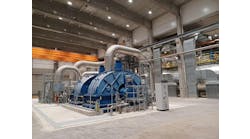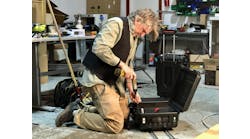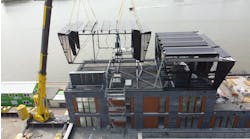Microgrids for trains, planes and ships are on the rise as the transportation industry seeks greener, more reliable power. The latest we’ve come upon is a plan by Imperial College London and 10:10 to work together on a project to create microgrid-like solar for trains.
The Renewable Traction Power project will look into using track-side solar panels to power the U.K.’s train lines, which is quite an undertaking, reports Imperial College London in a recent post.
“What is particularly galling is that peak generation from solar and peak demand from the trains more or less match, but we can’t connect the two,” said Leo Murray of 10:10, who is leading the Renewable Traction Power project. “I actually believe this represents a real opportunity for some innovative thinking.”
“I actually believe this represents a real opportunity for some innovative thinking.”
The U.K. isn’t the only one looking to renewable energy to power their electric trains. In fact, according to an article from Green Car Reports, the Netherlands is perhaps leading the charge.
The article shared that as of the first of this year, all electric passenger trains on the Dutch rail network now run on wind energy, according to a statement from operator NS.
More than just microgrids for trains
There’s a lot that makes the Renewable Traction electrification project in the U.K. a project to watch. The teams are trying to connect solar panels directly to the lines that provide electricity to trains. What’s the angle? This method works to bypass the grid so the panels can provide power when its most needed. Many in the industry see this project as the first of its kind.
The project will launch in February. It is a collaboration between 10:10, Turbo Power Systems, Community Energy South and Energy Futures Lab, and is funded through Innovate UK’s Energy Game Changers program. If the work succeeds in the U.K., the opportunities for microgrids for trains could skyrocket. By disconnecting from the grid, the economics of renewable energy for trains becomes more favorable and accessible to many more small and medium scale renewable developments.
But first things first. The team needs to find out if it’s possible to convert third rail systems, which provide electricity to the locomotive through a power line that lies near the ground. Although these systems are only used on about a third of the U.K.’s tracks, the team feels that “keeping it simple” will pay off.
“Many railway lines run through areas with great potential for solar power but where existing electricity networks are hard to access,” said Tim Green, director of Energy Futures Lab at Imperial College London, said in the post. “I think that focusing on the basics of integrating distributed energy generators into a railway’s system with the third-rail network brings a lot of benefits.”
There are still a lot of unknowns. For example, safety and integration of a secondary power source is a concern. This issue and more will be considered by researchers on the job from Imperial College London, who will focus on integration and management of power in the railway sector; and TPS, whose researchers will work on the distribution and management of power in the railway sector.
Transportation industry looking toward microgrid tech
Trains aren’t the first transportation method to go the way of the microgrid. Take planes, for example. Experiments in the flight industry are underway, as well. ‘Solar Impulse’ is a plane that is essentially a flying microgrid, which completed a round-the-world journey using no fossil fuels. The solar-powered plane finished the trip on July 23 in Abu Dhabi.
And for efforts across the pond from the Renewable Traction Power Project, Washington, D.C.-based Amtrak is planning a $31.3 million community microgrid so that it can keep its operations running during power outages.
One thing is for sure. Transportation is turning toward microgrid-like tech, and the outcome of the latest train project in the U.K. might have major implications for the future of the trend.
The leader of the new Renewable Traction Power Project had this to say about his confidence in the research teams tasked with the new initiative.
“TPS and Imperial really give us the full technical package,” said Murray. “We couldn’t have better partners to work out how we can integrate solar power with our trains.”
Do you subscribe to the free MicrogridKnowledge newsletter? Sign up today.






